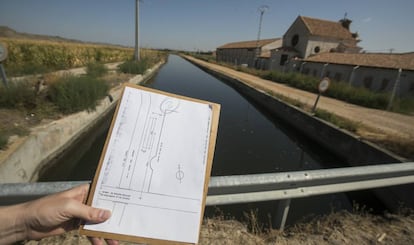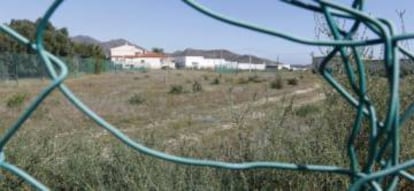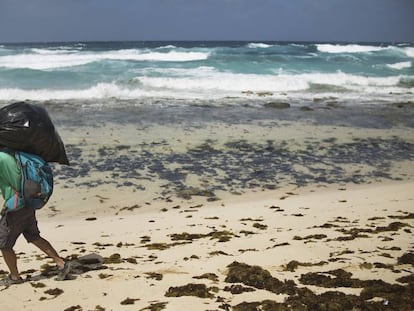Six sites in Spain have radioactive contamination, nuclear agency admits
Yet none of the areas are officially classified as contaminated ground due to a legal limbo

Spain’s Nuclear Security Council (CSN) has admitted the existence of radioactive contamination in an area located between Madrid and Toledo, as EL PAÍS revealed a few weeks ago. The agency also lists five more contaminated sites whose existence was previously known.

However, none of the six zones listed by the CSN are officially classified as contaminated ground because Spain has yet to produce a formal inventory of sites affected by radioactive leaks, a full decade after a royal decree ordered one to be drafted.
The CSN said that the Nuclear Energy Law needs to be amended first in order for the inventory to go ahead. And since 2008, no government has made any moves in this direction. In this legal limbo, the agency in charge of Spain’s nuclear security is simultaneously stating that these contaminated sites exist, but that they are not officially listed as such.
The Franco regime hushed up the accident and buried some of the contaminated soil along the Jarama canal
On November 7, 1970, several dozen liters of highly radioactive liquid from a spent nuclear fuel reprocessing operation leaked from the Juan Vigón National Nuclear Energy Center, located inside Madrid’s university campus. The liquid spilled into the sewer system and reached the Manzanares river; from there it flowed to the Jarama River, to the adjoining irrigation canal, and to the Tagus River.
The Franco regime, which was busy developing an atomic bomb under the Islero Project, hushed up the accident and the existence of contaminated soil, which it collected after draining the Jarama canal. The sludge considered to be least contaminated was then buried in eight ditches alongside the waterway. The legacy is still there, covered with weeds and lacking warning signs of any kind.
In its release, the CSN said that the Ecological Transition Ministry is working on legal changes to facilitate the approval of an official list of contaminated sites in Spain. This, said the oversight body, will help determine the need for cleanup operations or access restrictions.

“There are several sites showing radioactivity originating from human activity,” says the release. However, the CSN says that “it is estimated that there is no significant radiological risk.”
Besides the eight ditches along the Jarama, which are contaminated with cesium-137 and strontium-90, the CSN lists five other areas whose existence was already known. At the top of the list is Palomares, in southeastern Spain, where a US B-52 bomber collided in midair with a refueling plane on January 17, 1966, dropping four hydrogen bombs. While the bombs did not explode and nobody was killed, two of them released plutonium across the land.
There are two more contaminated sites on the Tinto River in Huelva province. One is located in the marshes of Mendaña, on the Tinto’s estuary, where there are high levels of cesium-137; the other site is near the spot where the Tinto meets the Odiel, and it contains significant amounts of radium-226.
Also on the list is El Hondón, a rural area in Cartagena (Murcia), which contains phosphate sludge and uranium-238; the last site is in the Ebro reservoir in Flix (Tarragona), where there was also phosphate sludge and uranium-238, although the CSN said that the sludge has already been removed from the site.
Right now there is no guarantee whatsoever that this toxic waste hasn’t been moved and scattered
Raúl Urquiaga, Jarama VIvo
On Wednesday, the environmental groups Ecologistas en Acción and Jarama Vivo staged a protest in one of the ditches along the Jarama, where they placed symbolic warning signs. “A mere visual inspection of the site clearly shows how easy it is to access,” said these groups in a release. This lack of oversight has meant that, over the years, some of the earth may have been moved around, “causing a possible risk of radioactive contamination to the local population.”
“Right now there is no guarantee whatsoever that this toxic waste hasn’t been moved and scattered,” said Raúl Urquiaga, of Jarama Vivo. “In fact, some of the sites are in the same spots as infrastructure such as the A-4 bypass, roads and transmission towers.”
English version by Susana Urra.
Tu suscripción se está usando en otro dispositivo
¿Quieres añadir otro usuario a tu suscripción?
Si continúas leyendo en este dispositivo, no se podrá leer en el otro.
FlechaTu suscripción se está usando en otro dispositivo y solo puedes acceder a EL PAÍS desde un dispositivo a la vez.
Si quieres compartir tu cuenta, cambia tu suscripción a la modalidad Premium, así podrás añadir otro usuario. Cada uno accederá con su propia cuenta de email, lo que os permitirá personalizar vuestra experiencia en EL PAÍS.
¿Tienes una suscripción de empresa? Accede aquí para contratar más cuentas.
En el caso de no saber quién está usando tu cuenta, te recomendamos cambiar tu contraseña aquí.
Si decides continuar compartiendo tu cuenta, este mensaje se mostrará en tu dispositivo y en el de la otra persona que está usando tu cuenta de forma indefinida, afectando a tu experiencia de lectura. Puedes consultar aquí los términos y condiciones de la suscripción digital.
More information
Archived In
Últimas noticias
A survivor’s account of the Interoceanic Train accident: ‘We were scared because of the speed on the curve’
The Interoceanic Train, the Mexican alternative to the Panama Canal
What is known about the Interoceanic Train derailment in Oaxaca
Trump turns a Minnesota fraud allegation into ammunition for his MAGA army against Democrats
Most viewed
- Oona Chaplin: ‘I told James Cameron that I was living in a treehouse and starting a permaculture project with a friend’
- Reinhard Genzel, Nobel laureate in physics: ‘One-minute videos will never give you the truth’
- Why the price of coffee has skyrocketed: from Brazilian plantations to specialty coffee houses
- Pablo Escobar’s hippos: A serious environmental problem, 40 years on
- Chevy Chase, the beloved comedian who was a monster off camera: ‘Not everyone hated him, just the people who’ve worked with him’










































